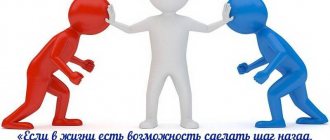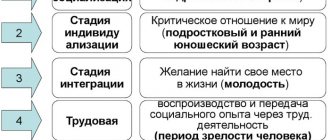What is conflict?
CONFLICT - (from the Latin “conflictus” - clash) - a clash of opposing goals, interests, positions, opinions or issues of interaction. at the heart of any conflict is a situation that includes: 1) either opposing positions of the parties on any issue; 2) either opposing goals or means of achieving them in given conditions; 3) or inequality of interests, desires, appetites of opponents, etc. [Dictionary of a practical psychologist].
Conflict is a confrontation between social actors in order to realize their conflicting interests, positions, values and views. [Fundamentals of conflictology].
There are different definitions of conflict, but at the heart of all conflicts there is a contradiction, that is, a situation in which one thing excludes the other. The world is contradictory. This structure is called ambivalent, dual. The conflict unfolds in the context of a contradictory world; it is, on the one hand, a form of existence of contradiction, on the other, one of the elements of an endless series of contradictions in reality, and, thirdly, the source of all development and movement.
“Good” and “evil”, “day” and “night”, “youth” and “old age”, “life” and “death”, “lack” and “need”, “strength” and “weakness”, “dream” ” and “reality”, “poverty” and “wealth”, “generosity” and “stinginess”, “love” and “hate”…. — when does conflict arise in this content-rich episode?
Only when a contradiction arises and unfolds in the sphere of interpersonal relations, between two individuals, between two subjects, carriers of an internal autonomous world, unique in its content and different from any other internal spiritual world.
Where there is no subject, there is no conflict. More precisely, the contradiction that arises in the interaction of two beings who are not individuals, are not subjects, is not characterized as a conflict, is not denoted by the term “conflict”. There are other categories for the area of collisions between animals and natural elements. The term “conflict” refers to the social, psychological, personal, and ideological spheres.
Two subjects faced with a clash of circumstances in contradiction must be able to recognize both their “I” in this clash and the “I” of the other subject. If the awareness of the contradiction between the two inner worlds of different “selves” does not occur, the collision should be qualified as a collision with an obstacle - and then a quarrel, a fight, a scandal arises - the obstacle is eliminated by means owned by the interaction partners.
Conflict is always accompanied by great psychological tension (that's why people dislike conflict so much!), and this tension is fueled by what in psychology is called personal meaning.
Conflict, as a phenomenon of reality, becomes a conflict for us personally when the confronting contradictions are personally significant for us. Even if they may seem absolutely meaningless on the scale of ordinary humanity. Moreover, some may care about them more, some less, and some may be completely indifferent to them. Personal meaning is the importance of such a measure on which our state, well-being and course of life depend, since what causes a contradiction is part of our personal content. “Personal meaning” is what a particular phenomenon means “to me,” what makes sense and touches our soul.
As long as there is no clash of personal meanings, there is no conflict, there are only different opinions about the same facts. We may love autumn while others love winter, but this contradiction only leads to conflict when it comes to taking time off for some well-deserved rest. Some people like silence, while others like noisy fun. And such a contradiction will lead to conflict only when circumstances force our interests to collide in the same place and at the same time. The conflict over the truth “2X2=4” does not arise precisely because this objective truth does not affect our interests, the moment of life.
Structure of the conflict
Analysis of a conflict involves studying its structure and functions. Without knowing either one or the other, it is difficult to manage conflicting relationships and approach this phenomenon meaningfully. In any conflict, functions depend on the structure, and the latter, especially its participants, can change under the influence of the dominant function.
What characterizes conflict in the first place? Of course, the parties to the conflict, as well as the subject of the confrontation. These two defining elements of the conflict do not exhaust its structure. The latter includes a conflict action in one form or another and the consciousness that controls it, the means and methods of action, the conflict field. Moreover, no conflict is possible without a conflict situation that arose before its occurrence.
The subjects of the conflict, depending on the level, are individuals, groups, classes, national and ethnic communities, organizations, social institutions, etc.
To analyze the conflict and its dynamics, it is important to identify the subject who initiates the conflict action and dominates this action. Moreover, it is not always the same item. The one who provoked the confrontation is often not the leader, not the determiner, but the follower, the determiner.
The behavior and actions of subjects are directed by conflict consciousness. It is formed by a special state of consciousness, the peculiarity of which is that opponents are aware of the antagonism of their interests, values, goals and turn them into motivation for activity.
Now to the topic of conflict. The material or spiritual object of life, in relation to which the opposite direction of human activity is formed, forms the subject of conflict. In a conflict, in addition to the real subject of confrontation, there may also be an imaginary, so to speak, quasi-subject. The real object is often hidden at first.
As can be seen from the above, understanding the subject of “conflict” is conceptual and is associated with the general approach of some authors to understanding the mechanism of the social process as a whole. The object of the conflict is the source. Depending on the depth of penetration of the analysis into the essence of social processes, the researcher determines a certain level of the basis of the conflict. For example, T. Parsons limits himself to explaining most conflicts by deviant behavior of people. “One of the sources of change,” he writes, “is the spread of deviant behavior, as well as the multiplication of various types of conflicts, and most conflicts contain as their main ingredients what can rightfully be called deviant behavior. This naturally leads to the conclusion that conflict is a temporary, pathological phenomenon.
The conflict object is a variable that characterizes all conflicts. Its analysis is always necessary, no matter what the conflicting relationship is.
To better understand conflict, it should be noted that there are different types of conflict behavior, which boil down to the following types:
Achieving the goals of one subject at the expense of another;
partial and complete concession of one subject to another;
mutual satisfaction of the interests of both conflicting subjects and the achievement of a common goal;
mutual dissatisfaction with the interests of conflicting subjects and the desire to take the conflict to a new level and into a new form.
Similar works
- Conflicts and ways to overcome them
- Conflicts and ways to overcome them
- Conflicts and ways to overcome them
- Conflicts and ways to overcome them
- Conflicts and ways to overcome them
- Conflict resolution in business communication
- Conflicts and ways to overcome them
- Conflicts in the personnel management system
- Methods for preventing and resolving conflicts
- Methods for preventing and resolving conflicts (Option 18)
- Conflict resolution in business communication
- Conflict resolution in business communication
- Methods for resolving conflicts
- Conflict management technology
- Behavior in conflict situations
- The emergence, development and resolution of conflict
- Conflict in business communication: structure, functions, ways of resolution
- Types, structure and stages of conflict
- Intragroup and intergroup conflicts in the organization
- Conflicts in the organization
Determination of conflict
This is a fundamental problem as it relates to revealing the nature of the conflict.
The main form of determination is the causality of the conflict, both direct and indirect. Conflict also arises under the influence of a number of factors that are not cause-and-effect in nature. These are spatiotemporal factors, functional connections, patterns of interaction between the system and its elements, the connection between the material and the spiritual, target determination, etc. The set of determining factors intertwines necessity and chance, dynamic and statistical relationships, rational and irrational, practical and spiritual, religious and scientific - depending on what conflict arises. Contradiction lies at the heart of conflict. Based on the contradiction, it is wrong to consider it to exist outside and independently of the activities of people’s consciousness.
Firstly, due to the diversity of conflicts, the reasons and conditions for their occurrence are also different. However, there are common determinants. Analysis of any type of conflict reveals objective and subjective reasons for its occurrence. Secondly, conflict is always a subjective-objective relationship (interaction) occurring in a social environment. Since it exists primarily in reality, but also in the imagination of the subjects, accordingly, the causes of the conflict are formed not outside this interaction, but within it, and are perceived and assessed differently by the subjects from the perspective of their interests.” From the definition of conflict as a struggle for the realization of opposing interests, the conclusion follows about the determining role of the latter in the complex of factors that determine conflicts. Thirdly, conflict is a multifaceted phenomenon in which different types of psychological elements are intertwined. The nature of conflicts does not exclude the influence of a biological factor on their occurrence. By focusing on objective causes and conditions, it would be one-sided to underestimate the role of intrasubjective, even irrational factors, including mentality and even instincts. All this generates opposition between subjects from the outside, passes through their consciousness and self-awareness and takes on a form that depends on many circumstances, primarily on the level of human culture.
The emergence of a conflict
A conflict arises when there is a conflict situation outside of which the process cannot be understood.
A conflict situation is the initial, preliminary stage of triggering the cause of the conflict. An indicator or expression of a conflict situation is the state of tension in the relations of certain subjects. Tension is a special state of consciousness and interaction of subjects, a special situation of perception and assessment of reality. Tension is a generalized characteristic of a conflict situation. Tension shows a certain level of awareness by subjects of the current contradiction or contradictions and the need to resolve them by understanding the incompatibility of the current situation with their interests. In short, tension is a state in which conflict, as they say, is knocking on the door.
The beginning of a conflict action presupposes the presence of a set of motives. A motive is not a reason, but an indication of the intentions of the subjects, which seems to them an adequate justification for their actions. Motives are formed on the basis of an assessment of the conflict situation as an incentive to action, as well as the behavior of the opponent, which is contrary to the interests of one of the parties, and one’s own actions.
The declared motives for conflicting actions are not always real, which in some cases is not even recognized by the parties to the conflict. And this is no coincidence: motives combine both conscious and unconscious approaches.
The implementation of a conflict situation, its transition into an obvious conflict, always begins with some kind of push: internal, emanating from one of the subjects of the contradiction, or external. The initial action that triggers a conflict is called an incident. It is an action by one party that causes a reaction from the other party.
“A conflict,” write E. Ksenchuk and M. Kriyanova, “consists of a conflict situation plus an incident.
An incident is the body of a conflict, its materialization, its image presented to the observer, its norm, which helps the subject clearly see the identified contradiction. The degree of tension rapidly increases, forcing the subject to look for a way out of the contradiction.
The event should be called the initiating cause. But not every incident acts in this capacity, but only one that is internally connected with conflict interaction. If the incident is outside the conflict contradiction, then it should be considered a trigger. A provocative act on the part of someone who wants to ignite the fire of conflict as quickly as possible will be an occasion, not a reason.
However, the deepest incentive for a conflict situation to escalate into a real conflict is a conflict of interest. If the starting point of confrontation in many cases is the incompatibility of values and positions, then the emergence of a conflict one way or another poses the problem of transforming values into transforming interests (Apter).
An undetected conflict situation is not as dangerous as an undetected incident, because the first still leads to awareness of existing contradictions if they are not eliminated by changing circumstances, the second drives the contradiction inside, and the increase in tension flows from consciousness, and a repeated incident immediately explodes the relationship and unexpectedly subjects takes the form of a violent dam break. This is where precedent arises - the previous case (Latin for “going ahead”).
A measure of the subject's psychological stress
Dissatisfaction is a feeling of dissatisfaction and an expression of dissatisfaction with something or someone, manifested by a grimace, intonation, plasticity, and sometimes vocabulary. On the one hand, dissatisfaction is not yet a conflict, since the subject is hardly aware of the cause of this state; the object of unrealized interest is still on the periphery of consciousness, but not at its center. On the other hand, dissatisfaction is already a conflict, since circumstances lead to a conflict of interests, although this conflict of interests is not yet clearly defined.
A person asks to be introduced at work during a visit to the dentist. The colleague complies with the request, quietly muttering to himself: “They always ride on me.” There seems to be no conflict here. But again, it doesn't seem like it's due to a flaw.
Discontent is a thin veil, indicating that, like a subtle ghost, contradiction hovers between subjects. Unacknowledged and therefore unresolved, it thickens, becomes more obvious and turns into a dispute.
Disagreement is a difference of opinions and views that have personal meaning to the subjects, such that they cannot compromise their opinions and views.
The next stage in the development of disagreement tension is resistance, which is an action that prevents another action.
There can be a long period of time between dissatisfaction and disagreement. The time between contradiction and confrontation is short: finally, awareness of the contradiction has occurred, and each subject knows what he wants, his desire to achieve his goal is growing rapidly. Thus, if subjects do not come to their senses here and now, do not use their active imagination, do not paint a picture of future relationships, do not direct their efforts to find a way to resolve the contradiction, they will not notice how they will find themselves at a level of confrontation where the level of tension is excessive.
The paradigm of confrontation is “I don’t want!” Every subject takes this position. (His version is “I still want it!”). The interests of the subject have eclipsed the whole world, the situation in which he and the other subject find himself, relationships, business, circumstances and, most importantly, the future. Everything is focused on a specific interest. It is difficult to get out of the confrontation, because the subjects of the conflict drive themselves into a tough position.
Conflict reaches its highest level of tension in confrontation, in the struggle with someone or something that, in the opinion of the subject, interferes with the achievement of a goal, the realization of interests. Since at a moment of high psychological stress it is the other person who is usually perceived as an obstacle, all forces are directed towards destroying this person. Methods of destruction or suppression are difficult to control, so the use of physical force, as well as humiliation, insult and insult to the opponent of the conflict, cannot be ruled out. If at the first stage (discontent) good relationships and connections have not yet been broken and there is no conflict yet, but at the same time it is already present, then at the last stage (confrontation) all connections are broken and the conflict has essentially disappeared, but it is still present.
The type of resolution we choose determines how the conflict will be resolved and how the relations between the subjects of the conflict will develop. This is the third stage of the conflict.
Causes of conflict situations
The most common prerequisites for the development of conflict:
- The root cause of discord may be banal dissatisfaction with something or someone. The situation worsens when hostility is cumulative. A person rams displeasure into himself, then breaks down and splashes out all the negativity. Usually in such a situation, emotions take precedence over reason.
- Self-doubt is another reason for the psychology of conflict. This is the seed of internal disagreement that does not allow a person to prove himself as a self-sufficient person. Sometimes this condition leads to depression.
- Another reason for the emergence of irreconcilable differences is the infringement of other people’s interests, which aggravate the situation by public clashes. Such disputes are common in society, especially in small groups.
Conflictogens
Observations show that 80% of conflicts arise without the will of the parties involved. This is due to the peculiarities of our psyche and the fact that most people either do not know them or do not attach importance to them.
The main role in the emergence of conflicts is played by the so-called conflict toxins. This word means "promoting conflict."
We call words, actions (or inactions) that can lead to conflict the cause of conflict.
The insidious nature of conflict agents can be explained by the fact that we are much more sensitive to what others say than to what we say. There is even an aphorism: “Women do not attach importance to what they say, but they attach great importance to what they hear themselves.” Indeed, everyone is to blame for this, not just the fair sex. This special sensitivity to words addressed to us comes from the desire to protect ourselves, our dignity from possible attacks. But we are not so vigilant when it comes to the dignity of other people, and therefore we do not pay such strict attention to their words and actions.
Personal psychological defense arises unconsciously as a system of personality stabilization that protects the individual’s sphere of consciousness from negative psychological influences. As a result of conflict, this system works involuntarily, against the will and desire of a person. The need for such protection arises when thoughts and feelings that threaten self-esteem, the formed “ego-image” of the individual, the system of value orientations, reduce the individual’s self-esteem.
In some cases, a person’s perception may be far from the real situation, but a person’s reaction to the situation is formed on the basis of his perception, on how it appears to him, and this circumstance significantly complicates the resolution of the conflict. Negative emotions generated by a conflict can be quickly transferred from the problem to the personality of the opponent, who will complement the conflict with a personal counter-reaction. The more the conflict escalates, the more unsightly the image of the opponent becomes, which makes it even more difficult to resolve. This creates a vicious circle that is very difficult to break. It is advisable to do this in the early stages of the event, before the situation gets out of control.
conclusions
Learning to manage conflict is not easy, but it is a most valuable skill for a company leader. Firstly, it helps to establish relationships between people, and secondly, it serves as a good engine of progress.
Please note that it is unwise to be afraid of conflict situations or avoid them. This makes employees “psychological hostages of the situation”, unable to act quickly and correctly. But trying to prevent by introducing an organizational chart, constantly working with staff (holding regular meetings, carrying out written communications to prevent distortions) is quite effective.
- Theoretical concepts of European design in the process of its formation and development in the first half of the twentieth century.
- Formation of the personality of a criminal (The concept of the personality of a criminal)
- Project management in e-commerce systems..
- PROJECT MANAGEMENT FUNCTIONS (Project Management. Fundamentals)
- The concept and scope of document flow in an organization (Unified documents)
- Main macroeconomic problems and their features in the Russian economy
- Organizational behavior in a cross-national context (commons and differences between countries).
- Types of wear and tear (Determination of the average percentage of wear and tear of comparable buildings for its transfer to the valuation object.)
- Level of development of social intelligence in people of different age groups
- Concept and characteristics of production organizations.
- Methodological aspects of assessing intangible assets and IP objects.
- Modern information projects and their features
Escalation of conflicts
A much greater danger is posed by ignoring a very important pattern - the escalation of conflict triggers. It happens like this:
We try to respond to a conflict togen directed at us with a stronger conflict togen, often the strongest possible.
Having received a conflict addressed to him, the victim wants to compensate for his psychological damage, so he feels the desire to get rid of his irritation by responding to the insult with an insult. It is difficult to resist the temptation to teach the offender a lesson. As a result, the power of the perpetrator of the conflict is rapidly growing. In trying to justify ourselves, we act on the principle that the best defense is an attack. Perhaps this is explained by the fact that the need to feel safe and comfortable, to maintain one’s dignity is one of the basic human needs, and therefore an attack on it is extremely painful. This pattern is compared with the well-known principle of mechanics: The reaction force is equal to the acting force, but is directed opposite to it. In humans, the reaction is usually stronger than the effect (not equal to it), another fundamental difference is that the mechanical principle works independently of our will, and we can still stop the escalation of conflicts by force of will.
Scheme 1.
The first one is more powerful, but even more powerful
conflict Þ response Þ response Þ response ÞiiiÞ CONFLICT
Conflict Conflict Conflict Conflict Conflict Conflict.
This is one of the circuits through which conflicts arise. This diagram helps to understand why 80% of conflicts arise spontaneously, without intention on the part of those involved in the conflict.
The initial trigger for conflict is often situational, outside the will of the people, and then the escalation of the conflict causes... And then conflict arises. To avoid conflict, the chain of conflict triggers must be broken somehow.
Types of conflict togens.
Most conflict togens can be classified into one of three types:
Striving for excellence;
Manifestation of aggressiveness;
Manifestation of selfishness.
What all these types have in common is that conflict togens are manifestations aimed at solving psychological problems or achieving specific goals (psychological or pragmatic).
Let's look at the most common conflict agents of each type.
Striving for excellence.
Condescending attitude, i.e. a demonstration of superiority, but with a tinge of goodwill: “Don’t be offended”, “Calm down”, “How can you not know?”, “They told you that in Russian...”.
Showing off causes irritation, a desire to “bring the show-off guy to his knees.”
Categorical, categorical - a manifestation of excessive confidence in one’s own rightness, self-confidence; implies superiority and subordination of the interlocutor. (Categorical phrases: “All men are scoundrels”, “All women are liars”, “Everyone steals” and “... and we’ll end the conversation here”). It is the categorical nature of the judgment that causes protest. Seek advice from yourself. There is one rule: give advice only when asked. The advisor essentially takes a position of superiority. The intentions are often the best, but the result is not what you expected.
Interrupting your interlocutor, raising your voice, or when you correct your interlocutor. This shows that his thoughts are more valuable than others, and he is the one who should be listened to.
Retention Information. Information is a necessary element of life. Lack of information creates a state of anxiety. Information may be hidden for various reasons, but nature abhors a vacuum, and the resulting vacuum is filled with speculation, rumors, gossip, which can be even worse.
Violations of ethical standards, both intentional and unintentional. (Using someone else's thoughts, but without citing the author; causing inconvenience, but without apologies, etc.).
BIBLIOGRAPHY
1. Kibanova A. Ya.. Personnel management - M.: INFRA-M, 2003.
2. Popov R.A. Anti-crisis management: Textbook for universities. – M.: “Higher School”, 2003. – 429 pages.
3. Psychology and ethics of business communication: Textbook for universities/Edited by prof. V.N. Lavrinenko. – 3rd ed., revised. and additional – M.: UNITY-DANA, 2001. – 326 p.
Attention!
If you need help writing a paper, we recommend turning to professionals. More than 70,000 authors are ready to help you right now. Free adjustments and improvements. Find out the cost of your work
Free estimate
0
Size: 19.66K
Downloads: 143
01/31/11 at 19:13 Author: Vasska
Liked? Click on the button below. It's not difficult for you
, and we
are pleased
).
To download test papers for free at maximum speed, register or log in to the site.
Important! All submitted Tests for free downloading are intended for drawing up a plan or basis for your own scientific works.
Friends! You have a unique opportunity to help students just like you! If our site helped you find the job you need, then you certainly understand how the job you add can make the work of others easier.
Add a job
If the Test work, in your opinion, is of poor quality, or you have already seen this work, please let us know.











